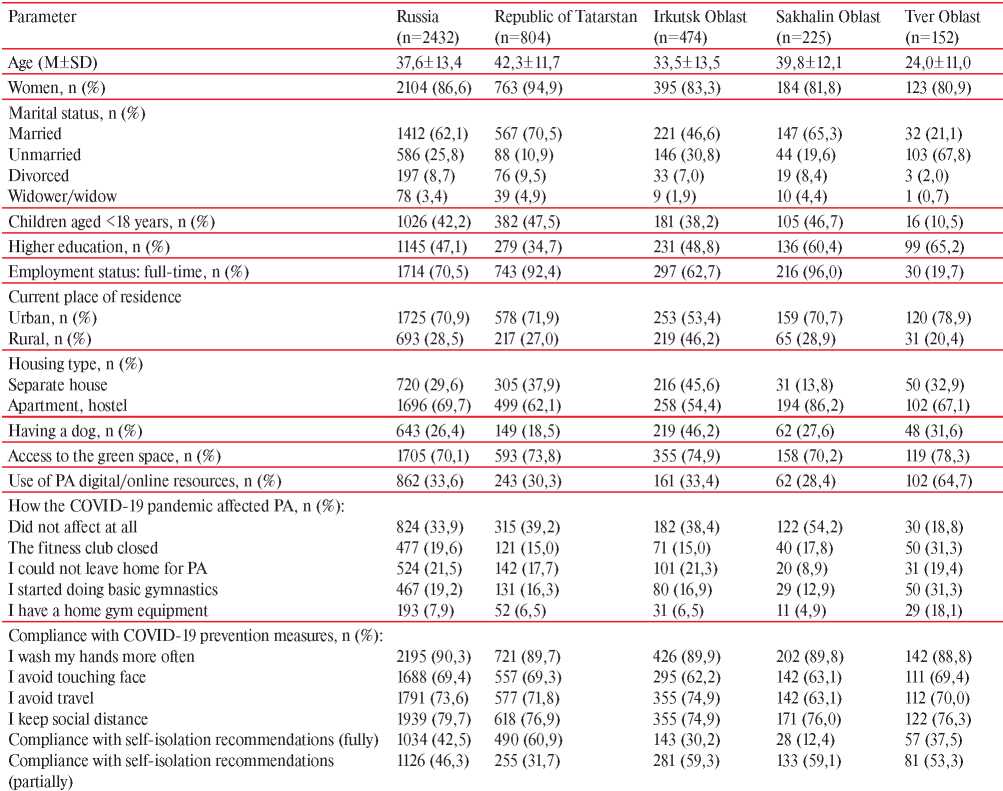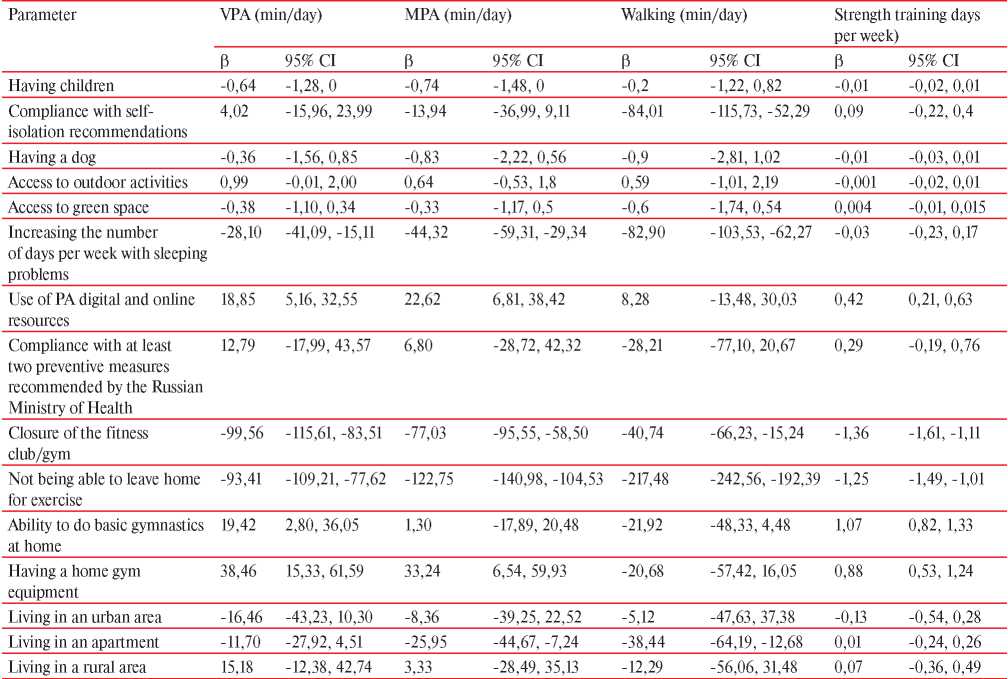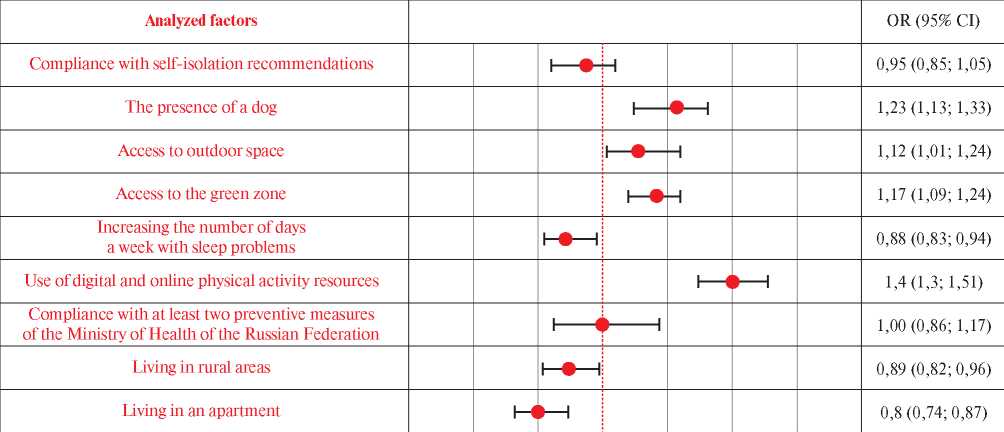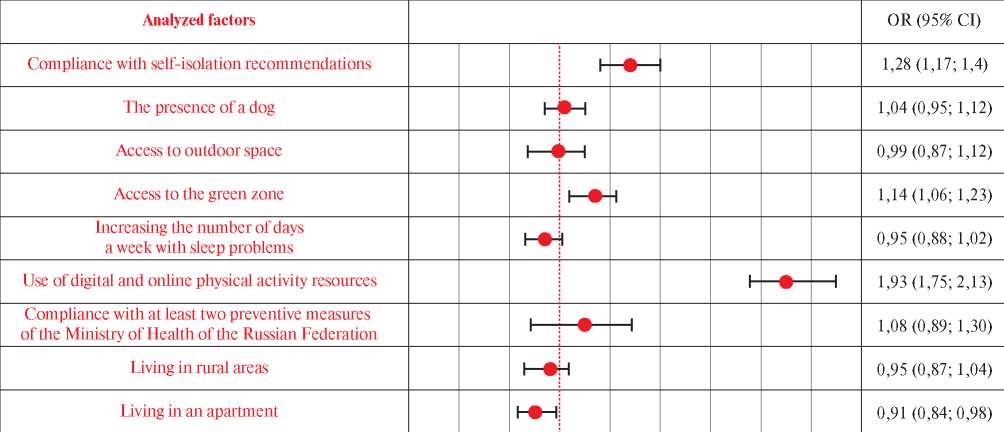Scroll to:
Association of COVID-19 lockdown measures with changes in physical activity of the adult population of Russia
https://doi.org/10.15829/1728-8800-2021-2938
Abstract
Aim. To assess the impact of lockdown measures during coronavirus disease 2019 (COVID-19) pandemic on physical activity (PA) of the adult population in Russia.
Material and methods. The online survey was conducted during the period of strict restrictions in Russia from April 26, 2020 to June 6, 2020. The survey involved respondents aged ≥18 years. Participants reported the frequency and duration of moderate to high-intensity PA, as well as walking and other types of exercise, before the pandemic and during the last seven days during the survey period.
Results. In the country as a whole, there was a decrease in all types of PA during the pandemic. The proportion of participants who met the World Health Organization recommendations for any type of PA decreased from 68 to 49% (p<0,001). Proportion of those who followed the World Health Organization recommendations for strength training for ≥2 days per week decreased from 53 to 45% (p<0,001).
Conclusion. The results of the study are the evidence base to substantiate the feasibility of measures aimed at correcting the lifestyle of the population in the context of the COVID-19 pandemic.
For citations:
Mukaneeva D.K., Kontsevaya A.V., Antsiferova A.A., Khalfiev I.N., Seledtsov A.A., Stolyarova E.A., Solovieva A.V., Popovich M.V., Drozdova L.Yu., Drapkina O.M. Association of COVID-19 lockdown measures with changes in physical activity of the adult population of Russia. Cardiovascular Therapy and Prevention. 2021;20(7):2938. https://doi.org/10.15829/1728-8800-2021-2938
Introduction
Physical activity (PA) is an important determinant of health [1] and is associated with all-cause mortality [2], cardiovascular disease and type 2 diabetes [3]. In November 2020, the World Health Organization (WHO) released updated guidelines on PA and sedentary behavior [4]. In adults, at least 150 min/week of moderate PA (MPA), or at least 75 min/week of vigorous-intensity PA (VPA), or a combination of MPA and VPA [4]. A meta-analysis of prospective studies showed that regular adherence to WHO recommendations for PA was associated with a 17% reduction in the risk of cardiovascular events, a 23% reduction in the risk of cardiovascular death, and a 26% reduction in the incidence of type 2 diabetes [5]. However, only one third of the adult Russian population comply with guidelines on PA, which is comparable to global data [6].
The pandemic of coronavirus disease 2019 (COVID-19), declared by WHO on March 11, 2020 [7], has led to significant changes in the lifestyle of population. As known, restrictive measures were taken to prevent the further spread of coronavirus infection; a quarantine or self-isolation was imposed around the world. Social distancing, travel bans, cancellations of sports and other public events, and changes in work and school hours have impacted the daily lives of Russians. In Russia, the main restrictions were imposed from March 28, 2020, but the extent of restrictions varied depending on the epidemiological situation in the region.
Research is conducted around the world to study the impact of COVID-19 pandemic on the level of PA in population. A recent systematic review of 66 studies (n=86981) reported a decrease in all types of PA and an increase in sitting time during the COVID-19 pandemic [8]. An Australian survey (n=1500) showed that almost half of the respondents reported a decrease in all types of PA compared to the period before COVID-19 pandemic [9]. PA changes in the study sample were associated with more pronounced symptoms of depression, anxiety, and stress. The results of an international survey of 1000 respondents from Europe, Asia, Africa, and America showed that restrictive measures led to a significant decrease in PA, both in the average number of days with activity and in its duration [10]. In Spain, survey participants reported a 20% (~45,2 min/week) decrease in PA during the first week of the nationwide lockdown compared to the previous week, and the proportion of those who met WHO guidelines fell from 61% to 49% [11]. In Greece, a survey of the adult population (n=8495) showed that the time spent on daily activities and sports was significantly reduced, while overall PA decreased by 16% [12]. In England, a survey of 723 adults in the first lockdown week showed that 35% of respondents were doing less PA, and 49% of respondents reported that they were doing more [13]. The results were similar when the number of study participants (n=2002) and the survey time increased: 40% of respondents reported a decrease in PA, while 45% — an increase [14]. In an international study conducted within 10 days of the announcement of pandemic, 455404 participants from 187 countries provided 19,1 million daily step counts. The average number of steps decreased during this time by 5,5%, and over the next 30 days — by 27,3% [15].
Recent studies show that regular moderate PA has a stimulating and strengthening effect on the immune system [16]. In this regard, an important aspect is to maintain an optimal level of PA, especially during a pandemic.
The aim of this study was to assess the impact of lockdown measures during COVID-19 pandemic on PA of the adult population in Russia.
Material and methods
Study design. From April 26 to June 6, 2020, the National Medical Research Center for Therapy and Preventive Medicine conducted an online survey of the adult population “Study of the impact of restrictions on population PA in conditions of self-isolation due to COVID-19”. The research methodology and country-wide results are presented in an international publication earlier [17].
The survey involved 2540 respondents aged >18 from 62 regions of the country. The sample size was 2432 people, since the results of 108 participants were excluded from the analysis, because some of the respondents did not fill out the questionnaire completely, and some of the survey participants were <18 years old. A number of regions ensured the participation of a significant number of respondents, which made it possible to assess some features within regions — the Republic of Tatarstan (n=804), Irkutsk (n=474), Sakhalin (n=225) and Tver Oblasts (n=152).
Questionnaire. In the spring of 2020, experts from the National Medical Research Center for Therapy and Preventive Medicine, based on foreign studies, developed a questionnaire aimed at studying the impact of COVID-19 restrictions on the lifestyle of population.
The questionnaire included 30 mostly closed-ended questions. Section 1 consisted of 10 questions regarding sociodemographic data and following self-isolation recommendations. Section 2 focused on assessing PA, sleep, and sedentary lifestyles before the COVID-19 pandemic and in the last 7 days of survey period. The PA assessment was carried out in accordance with the International Physical Activity Questionnaire Short Form (IPAQ-SF) recommended by WHO [18]. Changes in PA were assessed before and during the pandemic (in the last 7 days of survey period). Participants were asked to report the number of days per week and minutes per day spent on activities of varying intensity (MPA, VPA), walking, muscle strengthening workout, and gymnastics. The questions in Section 3 were devoted to adherence to the preventive measures recommended by the Russian Ministry of Health.
The study was approved by the Independent Ethics Committee of the National Medical Research Center for Therapy and Preventive Medicine.
Statistical processing was carried out using the SPSS 20 program. The distribution normality was assessed using the Kolmogorov-Smirnov test. Parametric Student’s t-test for depended samples was used to compare means. Comparison of qualitative variables (compliance with the WHO Guidelines) was carried out using the χ2 test.
Linear regression was used to test the relationship between PA changes and certain COVID-19 factors. We conducted logistic regression to identify factors influencing the implementation of PA recommendations. For this analysis, “compliance with WHO recommendations for PA (150 min/week of MPA or 75 min/week of VPA)” and “compliance with recommendations for muscle strengthening (≥2 days per week)” were selected as dependent variables. In addition, adherence to recommendations for self-isolation, availability of green space, an increase in the number of days per week with sleep problems, the use of digital PA resources, adherence to at least two preventive measures recommended by the Russian Ministry of Health, and geographical location were indicated as independent variables. The regression analysis models were adjusted for sex and age. Differences were considered significant at p<0,05.
Results
The characteristics of study sample are presented in Table 1. The mean age of respondents was 37,6±13,4 years. In the Tver Oblast, the mean age of participants was less and amounted to 24,0±11,0 years. Among the participants, there were 2104 women (86,6%). Most of the respondents lived in cities and in apartments.
The restrictive measures introduced in the spring of 2020 differed depending on the current epidemiological situation in the region (Table 2). Thus, the system of e-passes was used in the Republic of Tatarstan and the Irkutsk Oblast. Schoolchildren and students in all analyzed regions were switched to remote learning. Employees in all regions were switched to remote work, with the exception of the Sakhalin Region. The closure of fitness clubs, swimming pools, shopping malls occurred everywhere except for the Sakhalin region. Parks during this period were available for visiting in all regions.
As a result of restrictions due to the COVID-19 pandemic in Russia, there was a decrease in all types of PA (Table 3). The time spent on MPA and VPA, on average, decreased by 12 min/day — from 42,43±37,57 to 30,44±35,35 and from 37,79±37,80 to 26,56±34,69, respectively (p<0,001). The proportion of people who followed the WHO recommendations on MPA and VPA decreased from 68% to 49% (p<0,001). The proportion of those who did strength training ≥2 per week decreased from 53% to 45% (p<0,001). This trend was observed in all regions under consideration, with the exception of the Tver Oblast. Respondents in this region reported an increase in MPA time during the pandemic compared to pre COVID-19 from 36,3±33,2 to 47,6±48,1 min/day (p<0,001), while the proportion of persons following MPA recommendations increased from 28,2% to 44,9% (p<0,001).
The number of minutes spent walking per day decreased by ~20 minutes from 60,5±38,66 to 40,83±38,6 (p<0,001). Declines in the number of days and time spent walking occurred in all regions. However, the smallest decrease was found in the Sakhalin region — from 44,0±41,0 to 40,8±40,9 (p<0,001).
Online resources (for example, workout videos on YouTube, mobile fitness applications) were analyzed as a possible tool to increase PA, especially during the period of self-isolation and restrictions. Nationwide, only 34% of respondents reported using digital or online PA resources. In the Tver Oblast, this parameter was significantly higher and amounted to 64,7%.
An assessment of the relationship between changes in PA of varying intensity before and during the COVID-19 pandemic and individual factors affecting PA is presented in Table 4. A significant decrease in all types of PA (MPA, VPA, walking) was associated with an increase in the number of days per week with sleeping problems (β=-28,10; 95% confidence interval (CI): -41,09; -15,11; β=-44,32; 95% CI: -59,31; -29,34; and β=-82,90; 95% CI: -103,53; -62,27, respectively), fitness club closure (β=-99,56; 95% CI: -115,61; -83,51, β=-77,03, 95% CI: -95,55, -58,50, and β=-40,74, 95% CI: -66,23, -15,24, respectively) and the inability to leave home for exercise (β=-93,41; 95% CI: -109,21; -77,62; β=-122,75; 95% CI: -140,98; -104,53 and β=-217,48, 95% CI: -242,56, -192,39, respectively). A smaller reduction in the number of days with VPA and MPA was associated with the use of digital PA resources (β=18,85; 95% CI: 5,16; 32,55 and β=22,62; 95% CI: 6,81; 38,42, respectively), the presence of home gym equipment (β=38,46; 95% CI: 15,33; 61,59 and β=33,24; 95% CI: 6,54; 59,93, respectively). A reduction in the number of days per week with exercise was associated with fitness club closure (β=-1,36, 95% CI: -1,61; -1,11) and inability to leave home for exercise (β=-1,25, 95% CI: -1,49, -1,01). Factors associated with less reduction in the number of days per week with exercise included the use of digital PA resources (β=0,42; 95% CI: 0,21; 0,63), doing basic gymnastics at home (β=1,07; 95% CI: 0,82; 1,33) and the presence of home gym equipment (β=0,88, 95% CI: 0,53; 1,24).
We assessed the relationship between compliance with the WHO recommendations on PA and factors associated with COVID-19 (Figures 1, 2). Fulfillment of MPA and/or VPA recommendations was associated with the presence of a dog (odds ratio (OR)=1,23; 95% CI: 1,13; 1,33), access to the green space (OR=1,17; 95% CI: 1,09; 1,24), and using online resources (OR=1,40; 95% CI: 1,30; 1,51), while there was an inverse relationship with an increase in the number of days with sleeping problems (OR=0,88; 95% CI: 0,83; 0,94), and living in rural areas (OR=0,89; 95% CI: 0,82; 0,96). Compliance with exercise recommendations was associated with adherence to self-isolation (OR=1,28; 95% CI: 1,17; 1,40), access to the green space (OR=1,14; 95% CI: 1,06; 1,23) and using online and digital PA resources (OR=1,93; 95% CI: 1,75; 2,13).
Table 1
Characteristics of the study sample for Russia as a whole and for certain regions

Table 2
Restrictive measures in certain regions in force during the survey period

Table 3
PA before and during the COVID-19 pandemic

Note: * — р<0,05, ** — р<0,01, *** — р<0,001; WHO — World Health Organization, VPA — vigorous-intensity physical activity, MPA — moderate physical activity, COVID-19 — coronavirus disease 2019.
Table 4
Factors influencing PA during the COVID-19 pandemic

Note: adjusted for sex and age, VPA — vigorous-intensity physical activity, CI — confidence interval, MPA — moderate physical activity, PA — physical activity.

Figure 1. Factors associated with adherence to MPA and VPA recommendations.

Figure 2. Factors associated with adherence to strength training recommendations.
Discussion
This analysis showed that restrictive measures to COVID-19 prevent spread led to a change in the lifestyle of Russians and, first of all, to a change in PA. In the country as a whole, there was a decrease in all types of PA, both MPA and VPA, and walking, but regional differences were revealed. Self-isolation and fitness club closures were associated with greater declines in PA, while access to green space, use of PA online resources, and home exercise equipment were associated with smaller declines.
This is the first study to assess the impact of COVID-19 pandemic on PA of the Russian adult population. An international online survey on PA showed similar results, but did not include participants from Russia [10]. Other studies conducted in Australia [9], Poland [19], Spain [11], Greece [12] also reported a decrease in all types of PA and an increase in sitting time during the self-isolation and quarantine.
The study also identified factors associated with compliance with WHO guidelines for PA. People living in cities were more likely to follow the recommendations for PA, which is consistent with epidemiological studies obtained before the pandemic [20]. Living in a separate house, having a dog, using a home exercise equipment were also associated with compliance with PA recommendations. Participants living in a separate house have easier access to outdoor activities [21]. A recent systematic review demonstrated that the presence of a dog in the family is associated with an increase in PA [22]. The use of digital and online resources was also significantly associated with an increase in PA. Some evidence suggests that Internet technologies [23] and mobile applications [24] are effective measures to increase PA if participants follows the recommendations.
Ensuring opportunities for PA is important for strengthening the immune system and reducing susceptibility to infection. A recent international study showed that higher PA levels are associated with a lower hospitalization risk due to COVID-19 [25]. Conversely, a decrease in PA in patients with noncommunicable diseases increases both the risk of COVID-19 and the risk of cardiovascular and other complications [26]. To prevent the effects of COVID-19 restrictions on PA and, as a result, mental and physical health, a balance is needed between measures to prevent the infection spread and the provision of PA opportunities.
Conducting this kind of research is of great practical importance. So, the use of data obtained in order to develop and implement targeted measures to prevent risk factors, in particular low PA, and improve public health. The results of this study were used for Expert Consensus of the National Medical Research Center for Therapy and Preventive Medicine “Health promotion and prevention of chronic non-communicable diseases in the context of the COVID-19 pandemic” [27].
Study limitations. Although the present study has a number of strengths such as large sample size and data collection period, there are a number of limitations. Firstly, the study had cross-sectional design, i.e. participants assessed changes in PA before and during the COVID-19 pandemic, which could lead to distortion of data on the true level of PA. Secondly, since participants self-answered the questions, the data provided may have recall bias. Thirdly, among the survey participants, women predominated largely (87%). Based on the experience of similar online surveys in other countries, women are more committed to participating in such studies than men [28][29]. Fourthly, this study, like many other international studies conducted during the COVID-19 pandemic, was conducted online. This method has limitations, but is the only one available during this period and allows covering a large group of participants in a short time period.
Conclusion
Restrictive measures to prevent the COVID-19 spread led to a decrease in all types of PA, both MPA and VPA, and walking, but there were also regional differences. Self-isolation and fitness club closures were associated with greater declines in PA, while access to the green space, use of PA online resources, and home exercise equipment were associated with smaller declines.
The results of the study are the evidence base to substantiate the feasibility of measures aimed at correcting the population lifestyle in the context of COVID-19 pandemic. In future studies, it seems appropriate to assess the long-term effects of COVID-19 pandemic on the lifestyle of population.
Relationships and Activities: none.
References
1. Sygit KM, Sygit M, Wojtyła-Buciora P, et al. Physical activity as an important element in organizing and managing the lifestyle of populations in urban and rural environments. Ann Agric Environ Med. 2019;26(1):8-12. doi:10.26444/aaem/99177.
2. Cohen JA, Greaney ML, Sabik NJ. Assessment of Dietary Patterns, Physical Activity and Obesity From a National Survey: Rural-urban Health Disparities in Older Adults. PLoS One. 2018;13(12):e0208268. doi:10.1371/journal.pone.0208268.
3. Kivimäki M, Singh-Manoux A, Pentti J, et al. Physical inactivity, cardiometabolic disease, and risk of dementia: An individualparticipant meta-analysis. BMJ. 2019;365:l1495. doi:10.1136/bmj.l1495.
4. Bull FC, Al-Ansari SS, Biddle S, et al. World Health Organization 2020 guidelines on physical activity and sedentary behaviour. Br J Sports Med. 2020;54(24):1451-62. doi:10.1136/bjsports-2020-102955.
5. Wahid A, Manek N, Nichols M, et al. Quantifying the association between physical activity and cardiovascular disease and diabetes: A systematic review and meta-analysis. J Am Heart Assoc. 2016;5:e002495. doi:10.1161/JAHA.115.002495.
6. Guthold R, Stevens GA, Riley LM, et al. Worldwide trends in insufficient physical activity from 2001 to 2016: a pooled analysis of 358 population-based surveys with 1.9 million participants. Lancet Glob Health. 2018;6(10):e1077-86. doi:10.1016/S2214-109X(18)30357-7.
7. World Health Organization. Coronavirus Disease 2019 (COVID-19): Situation Report, 51. 2020. Available online: https://www.who.int/docs/default-source/coronaviruse/situationreports/20200311-sitrep-51-covid-19.pdf?sfvrsn=1ba62e57_10. (accessed on 22 December 2020).
8. Stockwell S, Trott M, Tully M, et al. Changes in physical activity and sedentary behaviours from before to during the COVID-19 pandemic lockdown: a systematic review. BMJ Open Sport Exerc Med. 2021;7:e000960. doi:10.1136/bmjsem-2020-000960.
9. Stanton R, To QG, Khalesi S, et al. Depression, Anxiety and Stress during COVID-19: Associations with Changes in Physical Activity, Sleep, Tobacco and Alcohol Use in Australian Adults. Int J Environ Res Public Health. 20207;17(11):4065. doi:10.3390/ijerph17114065.
10. Ammar A, Brach M, Trabelsi K, et al. Effects of COVID-19 Home Confinement on Eating Behaviour and Physical Activity: Results of the ECLB-COVID19 International Online Survey. Nutrients. 2020;12(6):1583. doi:10.3390/nu12061583.
11. López-Bueno R, Calatayud J, Andersen LL, et al. Immediate Impact of the COVID-19 Confinement on Physical Activity Levels in Spanish Adults. Sustainability. 2020;12(14):5708. doi:10.3390/su12145708.
12. Bourdas DI, Zacharakis ED. Impact of COVID-19 Lockdown on Physical Activity in a Sample of Greek Adults. Sports (Basel). 2020;8(10):139. doi:10.3390/sports8100139.
13. Robinson E, Gillespie S, Jones A. Weight-related lifestyle behaviours and the COVID-19 crisis: An online survey study of UK adults during social lockdown. Obes Sci Pract. 2020;6(6):735-40. doi:10.1002/osp4.442.
14. Robinson E, Boyland E, Chisholm A, et al. Obesity, eating behavior and physical activity during COVID-19 lockdown: A study of UK adults. Appetite. 2021;156:104853. doi:10.1016/j.appet.2020.104853.
15. Tison GH, Avram R, Kuhar P, et al. Worldwide Effect of COVID-19 on Physical Activity: A Descriptive Study. Ann Intern Med. 2020;173(9):767-70. doi:10.7326/M20-2665.
16. Simpson RJ, Campbell JP, Gleeson M, et al. Can exercise affect immune function to increase susceptibility to infection? Exerc Immunol Rev. 2020;26:8-22.
17. Kontsevaya AV, Mukaneeva DK, Myrzamatova AO, et al. Changes in physical activity and sleep habits among adults in Russian Federation during COVID-19: a cross-sectional study. BMC Public Health. 2021;21(1):893. doi:10.1186/s12889-021-10946-y.
18. Lee PH, Macfarlane DJ, Lam TH, Stewart SM. Validity of the International Physical Activity Questionnaire Short Form (IPAQSF): a systematic review. Int J Behav Nutr Phys Act. 2011;8:115. doi:10.1186/1479-5868-8-115.
19. Sidor A, Rzymski P. Dietary Choices and Habits during COVID-19 Lockdown: Experience from Poland. Nutrients. 2020;12(6):1657. doi:10.3390/nu12061657.
20. Balanova YuA, Kontsevaya AV, Shalnova SA, et al. The prevalence of behavioral risk factors for cardiovascular diseases in the Russian population according to the results of the ESSE-RF study. Russian Journal of Preventive Medicine and Public Health. 2014;17(5):42-52. (In Russ.)
21. Lambert A, Vlaar J, Herrington S, et al. What Is the Relationship between the Neighbourhood Built Environment and Time Spent in Outdoor Play? A Systematic Review. Int J Environ Res Public Health. 2019;16(20):3840. doi:10.3390/ijerph16203840.
22. Rhodes RE, Baranova M, Christian H, et al. Increasing physical activity by four legs rather than two: systematic review of dogfacilitated physical activity interventions. Br J Sports Med. 2020;54:1202-7. doi:10.1136/bjsports-2019-101156.
23. Jahangiry L, Farhangi MA, Shab-Bidar S, et al. Web-based physical activity interventions: a systematic review and meta-analysis of randomized controlled trials. Public Health. 2017;152:36-46. doi:10.1016/j.puhe.2017.06.005.
24. Romeo A, Edney S, Plotnikoff R, et al. Can smartphone apps increase physical activity? Systematic review and meta-analysis. J Med Internet Res. 2019;21(3):e12053. doi:10.2196/12053.
25. Zhang X, Li X, Sun Z, et al. Physical activity and COVID-19: an observational and Mendelian randomisation study. J Glob Health. 2020;10(2):020514. doi:10.7189/jogh-10-020514.
26. López-Sánchez GF, López-Bueno R, Gil-Salmerón A, et al. Comparison of physical activity levels in Spanish adults with chronic conditions before and during COVID-19 quarantine. Eur J Public Health. 2020:ckaa159. doi:10.1093/eurpub/ckaa159.
27. Drapkina OM, Gambaryan MG, Gorny BE, et al. Health promotion and prevention of chronic non-communicable diseases in the context of the COVID-19 pandemic. Consensus of experts of the National society of evidence-based pharmacotherapy and the Russian society of the prevention of non-communicable diseases. Cardiovascular Therapy and Prevention. 2020;19(3):2605. (In Russ.) doi:10.15829/1728-8800-2020-2605.
28. Ingram J, Maciejewski G, Hand CJ. Changes in Diet, Sleep, and Physical Activity Are Associated with Differences in Negative Mood During COVID-19 Lockdown. Front Psychol. 2020;11:588604. doi:10.3389/fpsyg.2020.588604.
29. Knell G, Robertson MC, Dooley EE, et al. Health Behavior Changes During COVID-19 Pandemic and Subsequent “Stay-atHome” Orders. Int J Environ Res Public Health. 2020;17(17):6268. doi:10.3390/ijerph17176268.
About the Authors
D. K. MukaneevaRussian Federation
Moscow
A. V. Kontsevaya
Russian Federation
Moscow
A. A. Antsiferova
Russian Federation
Moscow
I. N. Khalfiev
Russian Federation
Kazan
A. A. Seledtsov
Russian Federation
Irkutsk
E. A. Stolyarova
Russian Federation
Yuzhno-Sakhalinsk
A. V. Solovieva
Russian Federation
Tver
M. V. Popovich
Russian Federation
Moscow
L. Yu. Drozdova
Russian Federation
Moscow
O. M. Drapkina
Russian Federation
Moscow
Supplementary files
Review
For citations:
Mukaneeva D.K., Kontsevaya A.V., Antsiferova A.A., Khalfiev I.N., Seledtsov A.A., Stolyarova E.A., Solovieva A.V., Popovich M.V., Drozdova L.Yu., Drapkina O.M. Association of COVID-19 lockdown measures with changes in physical activity of the adult population of Russia. Cardiovascular Therapy and Prevention. 2021;20(7):2938. https://doi.org/10.15829/1728-8800-2021-2938

























































